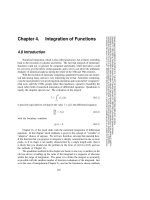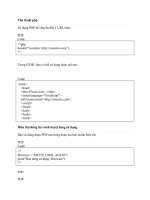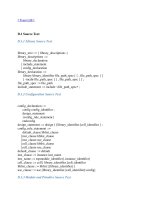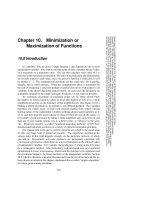Tài liệu Evaluation of Functions part 1 docx
Bạn đang xem bản rút gọn của tài liệu. Xem và tải ngay bản đầy đủ của tài liệu tại đây (42.58 KB, 1 trang )
Sample page from NUMERICAL RECIPES IN C: THE ART OF SCIENTIFIC COMPUTING (ISBN 0-521-43108-5)
Copyright (C) 1988-1992 by Cambridge University Press.Programs Copyright (C) 1988-1992 by Numerical Recipes Software.
Permission is granted for internet users to make one paper copy for their own personal use. Further reproduction, or any copying of machine-
readable files (including this one) to any servercomputer, is strictly prohibited. To order Numerical Recipes books,diskettes, or CDROMs
visit website or call 1-800-872-7423 (North America only),or send email to (outside North America).
Chapter 5. Evaluation of Functions
5.0 Introduction
The purpose of this chapter is to acquaint you with a selection of the techniques
that are frequently used in evaluating functions. In Chapter 6, we will apply and
illustrate these techniques by giving routines for a variety of specific functions.
The purposes of this chapter and the next are thus mostly in harmony, but there
is nevertheless some tension between them: Routines that are clearest and most
illustrative of the general techniques of this chapter are not always the methods of
choice for a particular special function. By comparing this chapter to the next one,
you should get some idea of the balance between “general” and “special” methods
that occurs in practice.
Insofar as that balance favors general methods, this chapter should give you
ideas about how to write your own routine for the evaluation of a function which,
while “special” to you, is not so special as to be included in Chapter 6 or the
standard program libraries.
CITED REFERENCES AND FURTHER READING:
Fike, C.T. 1968,
Computer Evaluation of Mathematical Functions
(Englewood Cliffs, NJ:Prentice-
Hall).
Lanczos, C. 1956,
Applied Analysis
; reprinted 1988 (New York: Dover), Chapter 7.
5.1 Series and Their Convergence
Everybodyknows thatan analytic functioncan be expanded inthe neighborhood
of a point x
0
in a power series,
f(x)=
∞
k=0
a
k
(x − x
0
)
k
(5.1.1)
Such series are straightforward to evaluate. You don’t, of course, evaluate the kth
power of x −x
0
ab initio for each term; rather you keep the k − 1st power and update
it with a multiply. Similarly, the form of the coefficients a is often such as to make
use of previous work: Terms like k! or (2k)! can be updated in a multiply or two.
165









